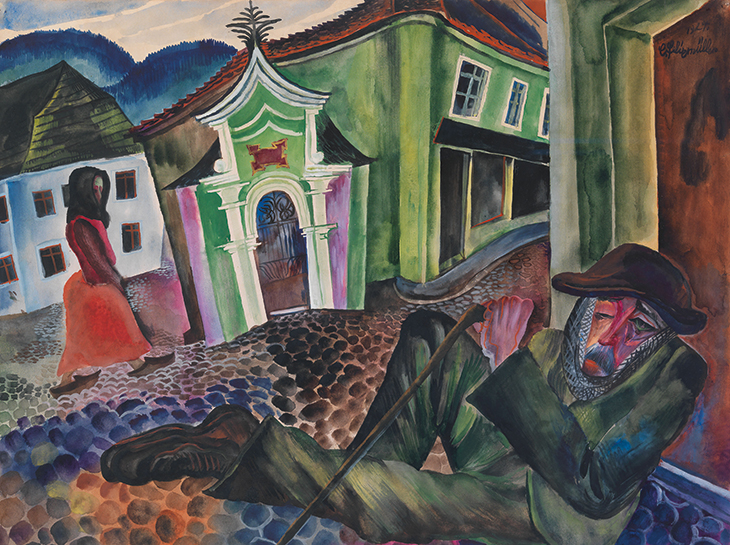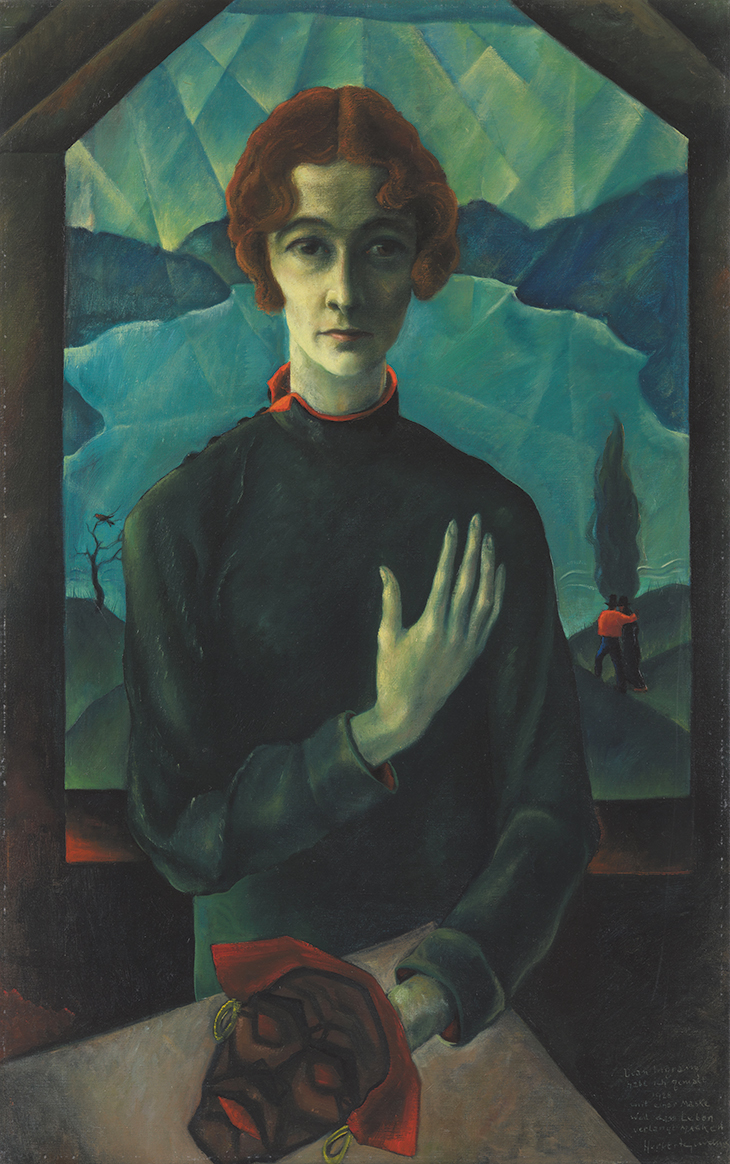‘I no longer hate people indiscriminately,’ wrote George Grosz in 1924. ‘Today I hate their bad institutions and those in power who defend those institutions.’ The German painter was bitter, damaged by the war, and angry at the systems that caused it. In his paintings he mocked the military, exposed the church, and sent up the middle classes in unflattering satirical sketches. But he underestimated the extent of his hatred towards people. A painting from 1916 reveals the range of his misanthropy, its figures anticipating the moral dereliction of the post-war years. Suicide (1916) depicts a street at night, with a dead man sprawled in the foreground, skull visible through his skin, and dogs curling around corners. A man shuffles by, and a prostitute, leaning out of her window, surveys the blood-red scene. The figures are in caricature, the angles of the buildings absurd, yet there’s an authentic darkness to Grosz’s scene, in which every detail is symptomatic of social collapse.
Suicide (1916), George Grosz. Tate, London. © Estate of George Grosz, Princeton, N.J. 2018

Grosz briefly served at the front in 1915 before being discharged from the army on the grounds of poor health, though his experience of the trenches was enough to cement his despair over Germany. He belonged to a generation of artists traumatised by the First World War and hostile towards a country in the grip of economic depression. These are the years brought into focus in ‘Magic Realism’ at Tate Modern, an exhibition surveying Germany’s interwar period through artworks that reflect its turbulence: the collapse of the German empire, the brief respite of the ‘golden twenties’, the hopes of the Weimar Republic shattered by further economic collapse, unemployment, and the rise of National Socialism. Featuring 70 works, the exhibition draws heavily on the George Economou Collection, supplemented by works from Tate’s own holdings.
Franz Roh coined the term ‘magic realism’ in 1925 in an attempt to describe artists turning away from pre-war idealism, and the affective style of expressionism, towards grittier political subjects. Cartoonish and often grotesque, the paintings produced in Weimar range in subject from abortion to the supernatural, and reveal artists relishing the creative freedoms of post-war liberalism. Run-down streets give way to smoky nightclubs; the threat of sexual violence transmutes into the possibility of encounter; women enjoy their bodies, and go out in public. But the period’s progressiveness was short-lived: by 1937, Hitler had denounced modern art as ‘degenerate’ and hoisted many of the works up for ridicule.
The Beggar of Prachatice (1924), Conrad Felixmüller, The George Economou Collection. © DACS, 2018

The residue of First World War violence is palpable in the art of the 1920s, in which artists mete out their trauma on carnivalesque scenes and female subjects. In his series of Circus prints from 1922, Otto Dix – who fought in the Battle of the Somme – depicts the darkened corners of circus tents, where sailors and strongmen have animal faces and impossibly sharp teeth. For Dix and his contemporaries, imagined violence became indivisible from real, and dark fantasies often played out on canvas. A trend for paintings depicting suicide (which reflected Germany’s alarming post-war suicide rate) resulted in works such as Rudolf Schlichter’s The Artist with Two Hanged Women (1924), in which the line between violence and sexual fetish is uncomfortably blurred.
The largest room of the exhibition is given to street scenes and studio portraits that capture the period of relative prosperity hailed as Berlin’s ‘golden twenties’. The portraits are highly detailed but cold and exacting, revealing artists’ experimentation with new forms of realist depiction. Herbert Gurschner plays with strange details: a female figure painted as if on porcelain in Japanese Lady (1932); a sitter concealing her hand with a mask in Bean Ingram (1928). Most disconcerting are their backdrops: in Lady with Red Scarf (Speedy with the Moon) (1933), Schlichter places his well-dressed wife in a withered, fantastical landscape, its desert-like rock formations matching her confrontational gaze. Was Schlichter’s sombre landscape a metaphor for interwar Europe? While modernist centres such as Berlin were experiencing cultural and economic prosperity, regional European towns were poor, and in urban and provincial scenes social inequality is explicit. In Conrad Felixmüller’s The Beggar of Prachatice (1924), a peasant woman with clogs on her feet walks to work, passing a war veteran begging on the street. Though Berlin revellers might not have known it, post-war dreams of a new social order were far from realised.
Bean Ingram (1928), Herbert Gurschner. The George Economou Collection. Reproduced with permission of Kunsthandel Widder, Vienna

The exhibition is slow to consider the position of women artists within Weimar society but, towards the end of the exhibition, a small cluster of drawings introduces the work of Jeanne Mammen. Mammen’s drawings – gauzy depictions of women in watercolour, pen and ink – illustrated fashion magazines and poetry publications throughout the 1920s, until the Nazis shut down the journals she worked for and she went into inner exile, refusing to show her work. Here, they fill an important gap in describing women’s experiences of city life. Mammen observed women on the streets of Berlin and in nightclubs, and often depicted them in conversation, smoking, or playing cards. In Brüderstrasse (Free Room) (1930), the women are intimate and aloof; in Boring Dolls (1929), they’re defiant, out for their own pleasure.
Brüderstrasse (Free Room) (1930), Jeanne Mammen. The George Economou Collection © DACS, 2018

It’s hard to pinpoint exactly what Roh meant by ‘magic realism’: the works on show are neither particularly magical nor real. And it’s often unclear how seriously they take themselves: Grosz’s portraits are satirical, and Gurschner’s severe. The exhibition doesn’t quite tease out the paradoxes between trauma and humour, leaving both to loiter in the murkiness of Dix’s circus tent. What we’re given is a vision of a world that hinges on reality yet twists from view. It’s a distortion of the truth, full of landscapes littered with war debris and nightclub corners filled with smoke. It’s the same world, but darker than before.
‘Magic Realism: Art in Weimar Germany 1919–33’ is at Tate Modern, London, until 14 July 2019.
From the October 2018 issue of Apollo. Preview and subscribe here.



